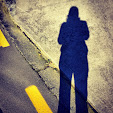Rationale
The sensory/emotional experiment
for project two became an elaboration on the topic of using the toilet. The
process of working though the first project reinforced the importance of
privacy that is a natural part of any enquiry into toilet use. It was clear
that it would be more beneficial to introduce a means for further investigating
the emotion of the act that was more socially acceptable. Reading material
designed specifically for use in the toilet seemed an obvious solution. The
result was three experiments in reading material that could alter the mood of
the user whilst he or she is engaged in the act of using a toilet.
The first experiment was an
exercise in translating the meaning of austerity so that the publication
produced to evoke this emotion was devoid of any abstraction and became a
literal translation of the word. The suggestion is that all that is required to
fulfil the task of a toilet is a singular receptacle, irrespective of its age
or state. Hence the rusty bucket suggests the concept of going ‘back to
reality’, while the recycled paper further emphasises sustainability and social
responsible design (Atfield, 2000). The
absence of text, with the exception of the word itself expresses the minimalism
of austerity.
The physical as well as the
mental state of comfort is bound up in this pictorial representation of the
understanding of comfort resulting from project one. The responses from those
interviews contained a clear message regarding the priority the participants granted
to security and hygiene while using the toilet. While comfort has in the past been more
closely associated with bereavement and spirituality, these priorities are more
in tune with the contemporary understanding of the word. (Shove, 2004) The
locked door responds directly to the user’s need for privacy and the fur
suggests the comfort of cuddly toys while the whole piece is contained in a
Ziploc bag with the words confirming its fresh and clean state being all that
are required to suggest comfort to the reader.
The most comprehensive experiment
relates to glamour. Just as beauty is in the eye of the beholder, so too is
glamour, the judgment of which is at least partly subjective. While it was used
to describe sorcery previous to the twentieth century it was to become
synonymous with the artifice of American cinema between the 1930s and 1950s
(Dyhouse, 2011). The magazine makes use of a familiar magazine format to subtly
ridicule the contemporary understanding of Hollywood-style glamour through complete
redesign of the inside and outside pages of the cover. The front cover
promoting the feature articles as well as the three pages of advertising are
exclusively about the use of the toilet. The use of celebrity faces and
well-known brands accentuates the appeal of the magazine. The reader will feel
glamorous by association.
An interesting by-product of each
of the experiments is humour, which may be a reflex action to the subject
matter. There is a natural tendency within western cultures to allay discomfort
with humour, which might explain this occurrence.
Shove,E.(2004) Comfort, Cleanliness and Convenience: The
Social Organisation of Normality. London: Berg
Attfield, J. (2000) Wild
& Things. London: Berg
Dyhouse,C. (2011) Glamour: Women, History, Feminism. London: Zed Books
































.jpg)






